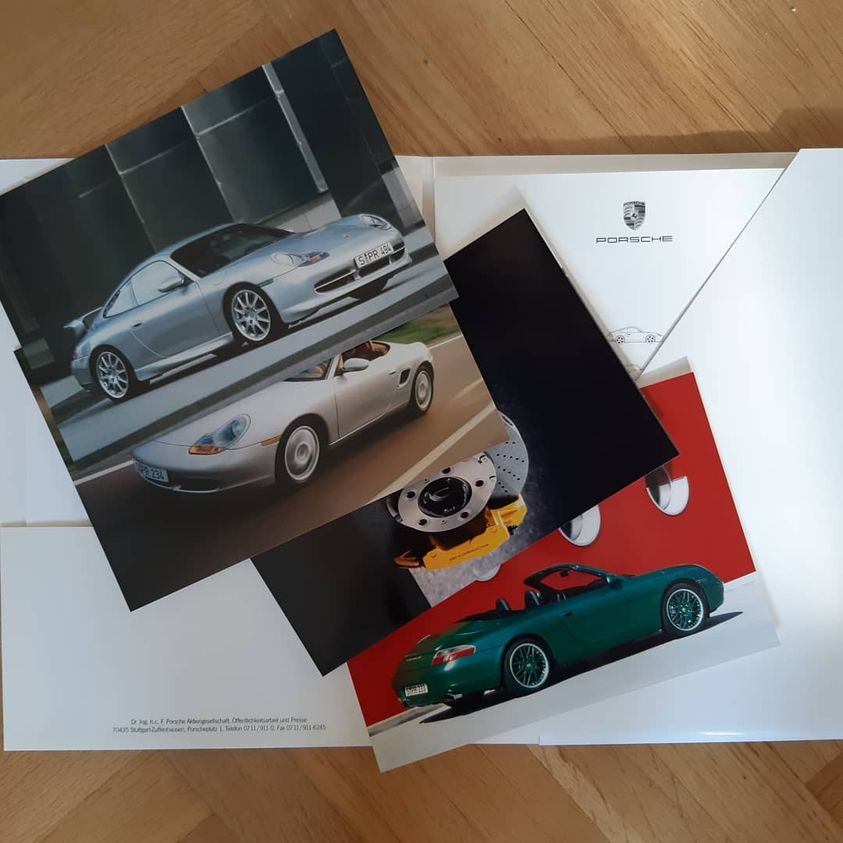
Porsche Press kit 2000
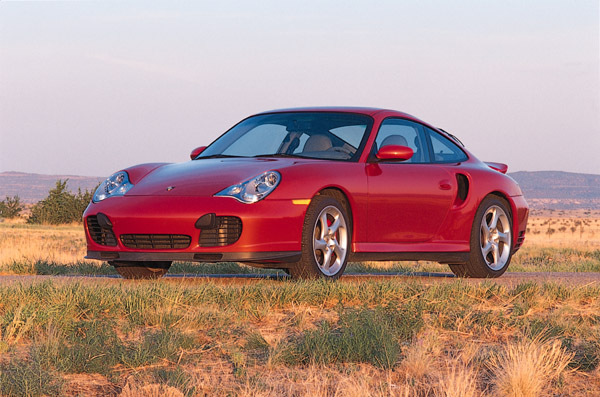
ATLANTA – Porsche introduced the first 911™ Turbo in model-year 1975 (1976 in North America), just as rising gasoline prices and emission controls were starting to decimate the ranks of performance cars. This landmark car immediately redefined the term “supercar” with performance that could shame exotics having twice the cylinder count – 0-62 mph (0-100 km/h) in just 5.5 seconds.
At the same time, the 911 Turbo offered better everyday driveability and comfort than other exotics, plus proven Porsche quality. By today’s standards, a 6.5-to-1 compression ratio, thermal reactor emission controls, a four-speed transmission and 15-inch wheels hardly seem the ingredients of a supercar. Yet , the first 911 Turbo established a dynasty on those humble-sounding numbers.
The first 911 Turbo also established a “Turbo look” with its deep front airdam, heavily flared wheelwells and the trademark “whale tail” rear spoiler. Primitive-for-the time emission controls kept the U.S. version at 234 horsepower, compared to 260 horsepower for other markets. Still, that was a big boost over the U.S.-spec 165-horsepower 911 Carrera®, previously the top model in the line.
Equally important, the 3.0-liter single-turbo engine produced 253 lb.-ft. of torque at 4,000 rpm, far more than any production Porsche before it. It was enough torque that Porsche deemed a four-speed manual transmission s u fficient. Porsche engineers also introduced the first turbocharger “wastegate,” a bypass valve that bled off excess exhaust pressure when maximum boost was achieved.
Twenty-five years ago, air conditioning, tinted glass, a power sunroof, four-speaker stereo, headlight washers and foglamps meant luxury in a Porsche. The first 911 Turbo included all those features as standard equipment.
For 1978, Porsche unleashed an even more powerful 911 Turbo. A larger bore and stroke increased displacement to 3.3 liters. Even bigger news lie under the grill in the whale tail spoiler – the first air-to-air intercooler in a turbocharged production car. Pressurizing the incoming air charge raises the c h a rge temperature, preventing the engine from realizing the full potential of the turbo. An intercooler reduces the charge temperature, improving performance.
The intercooler in the 1978 911 Turbo reduced the charge temperature by more than 100 degrees Fahrenheit to less than 212 degrees and allowed Porsche to raise the compression ratio to 7.0-to-1. Horsepower in European models jumped to 300, although U.S. customers had to get by with “only” 265 hp. To rque for the U.S. car jumped to 291 lb.-ft. The 0-62 mph (0-100 km/h) performance improved, Porsche said then, by one-tenth of a second to 5.4 seconds. Porsche installed 16-inch wheels on the 911 Turbo that year, with 205/55 VR16 tires in front and 225/50 VR15 tires in the back.
Porsche built 17,791 911 Turbos with the 3.3-liter engine over a 12-year span. Unfortunately, enthusiasts in America did not see the car for that long. In 1979 Porsche had to pull the 911 Turbo from the U.S. model line, because the car could not meet the ever-tightening emissions standards. It would take the introduction of catalytic converters and an oxygen sensor to bring the car back for 1986, now with 282 horsepower and 288 lb.-ft. of torque.
Porsche turned up the excitement in 1987 by offering the 911 Turbo in Cabriolet and Targa models in addition to the coupe. A five-speed manual transmission replaced the four-speed for 1989, but the 911 Turbo took a one-year hiatus when Porsche introduced a new-generation 911 Carrera and all-wheel drive 911 Carrera 4 for 1990.
When the 911 Turbo emerged in the U.S. again for 1991, it scorched the road with the same 320 horsepower as in other markets.
A new coil spring suspension replaced torsion bars, and an anti-lock brake system (ABS) became standard. Other safety news included the addition of a Supplemental Restraint System with dual front airbags.
The boost in horsepower and torque (now at 332 lb.-ft.) came from a new resonant intake manifold, a larger intercooler and a remapped Motronic engine control unit. Compression ratio remained at 7.0-to-1, and the turbo produced 10.1 psi of maximum boost. Riding on 17-inch wheels, the 1991-1993 911 Turbo could blast from 0-62 mph (0-100 km/h) in five seconds flat.
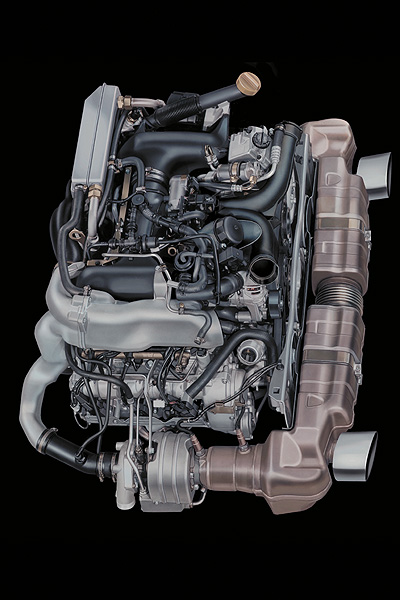
The 1993 911 Turbo introduced a larger 3.6-liter turbocharged version of Carrera engine. With a higher 7.5-to-1 compression ratio and larger turbo that developed 12.3 psi maximum boost, this engine produced a truly staggering 360 horsepower and 383 lb.-ft. of torque. For anyone who doubted there was a substitute for cubic inches, one drive in a 911 Turbo could effect the appropriate attitude adjustment. The new 18-inch wheels measured eight inches wide in front and 10 inches wide in back.
This final single-turbo model broke the five-second barrier, achieving 0-62 mph (0-100 km/h) in just 4.8 seconds.
The 1993 911 Turbo featured larger internally vented, cross-drilled brake discs – 12.68 inches in diameter for the front and 11.77 inches in the rear. Red-painted four-piston brake calipers appeared for the first time and have been a 911 Turbo signature ever since.
The 911 Turbo took another year off for 1995, when Porsche introduced the redesigned 911 Carrera and 911 Carrera 4. The mighty Turbo resurfaced in 1996 with 400 horsepower and 400 lb.-ft. of torque. The power boost came fro m dual turbochargers running in parallel and featuring integrated wastegates. Dual intercoolers now occupied the space beneath the whale tail spoiler.
As enthusiasts had been hoping, Porsche built the latest 911 Turbo on the all wheel drive platform of the 911 Carrera 4, complete with a six-speed transmission. Together with multilink rear suspension, the viscous clutch-based all wheel drive system made this the best-handling 911 Turbo ever.
Engine tuning reflected a greater emphasis on low-end torque, and the new Turbo produced more than 80 percent of peak torque (or 332 lb.-ft.) at only 2,500 rpm. The 0-62 mph (0-100 km/h) performance dipped even lower, to 4.5 seconds, and top track speed rose to 180 mph (290 km/h).
The brakes were the most advanced ever on a 911 Turbo, including four-channel ABS 5.0, an electrohydraulic brake booster, and internally vented and c ross-drilled discs measuring 12.68-in. diameter in front and re a r. Deceleration was as impressive as acceleration – the 911 Turbo could go from 62-0 mph (100-0 km/h) in less than three seconds. Traction control – functional up to 44 mph – enhanced driving safety.
The 1996 911 Turbo was 2.36 in. wider than the 911 Carerra 4, with dramatically flared wheelwells to enclose massive tires – 225/40ZR 18 in front and 285/35 ZR18 in the rear. The hollow-spoke alloy wheels, the first of their kind on a production car, reduced wheel weight by 30 percent.
With each generation of the 911 Turbo came more performance, more safety, more luxury and more sales. The 1995-1998 model became the best-selling 911 Turbo yet. The last one to roll out of the factory in April 1998 brought the production total for that series to 5,978 (2,244 sold in the U.S.). Total 911 Turbo production since 1974 reached 32,223 – with 9,697 sold in the U.S.
The 1995-1998 911 Turbo was the quickest, fastest, best-handling, most luxurious Turbo in the model’s history – until the all-new 911 Turbo arrived for 2001.
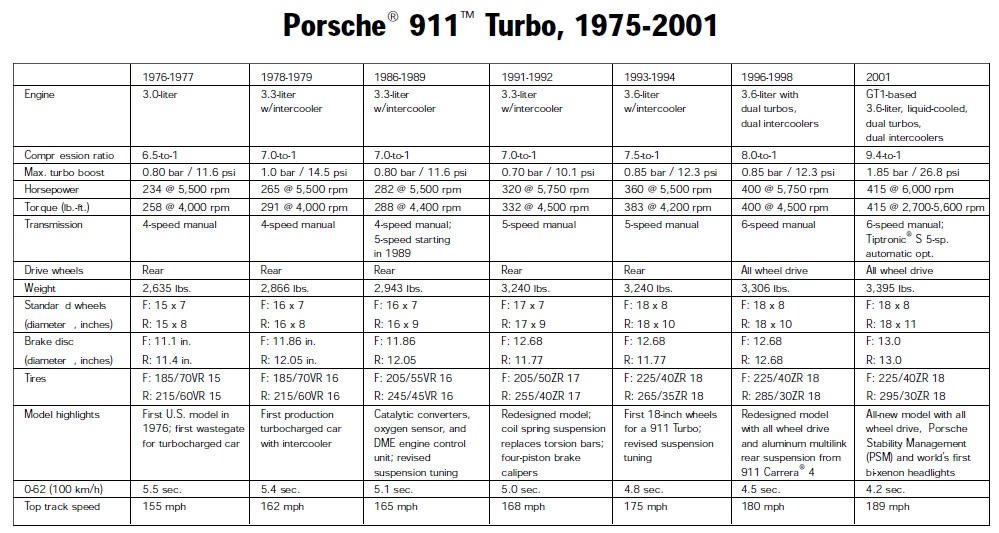

Porsche Press kit 2000
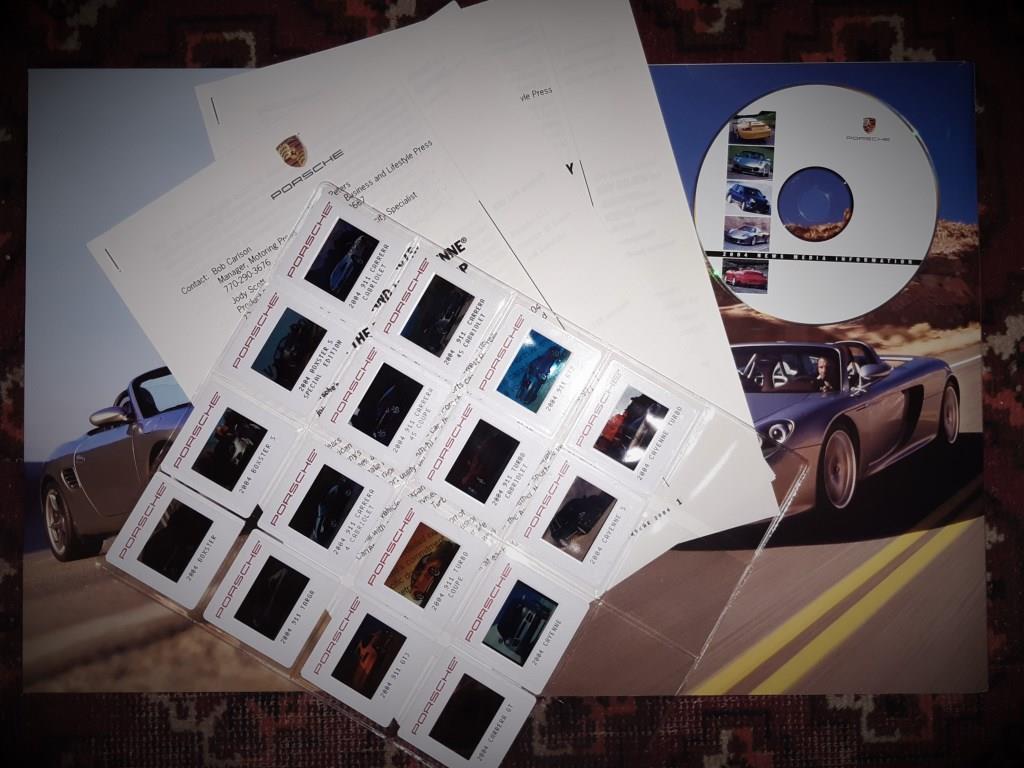
Porsche Press kit 2004 - USA

Porsche Press kit

Porsche Literature

Our Porsche Cars